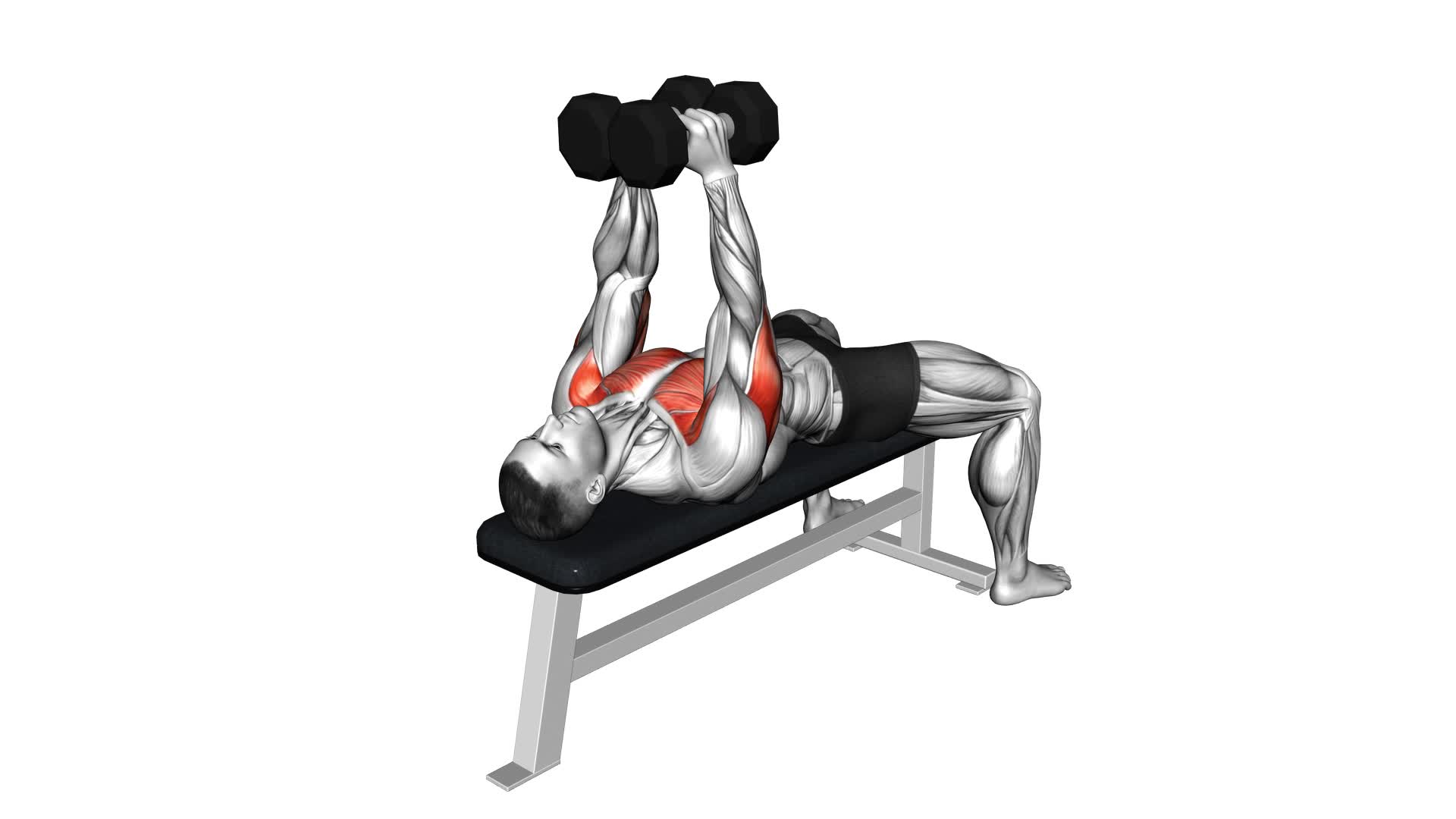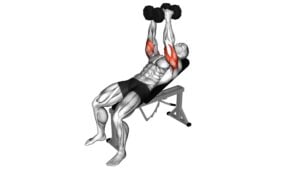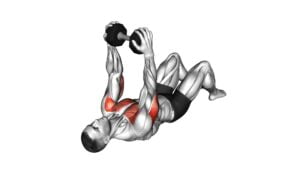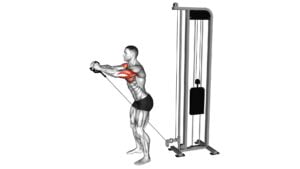Dumbbell Squeeze Bench Press – Video Exercise Guide & Tips

Are you looking for a new exercise to add to your workout routine? Check out the Dumbbell Squeeze Bench Press!
Watch This Exercise Video
This exercise targets your chest and triceps while also engaging your core.
In this video exercise guide, you'll learn the proper form and technique, as well as variations and modifications to challenge yourself.
Avoid common mistakes and get tips for increasing intensity.
Get ready to level up your workout with the Dumbbell Squeeze Bench Press!
Key Takeaways
- The dumbbell squeeze bench press targets the chest, shoulders, and triceps while engaging core muscles.
- Proper hand positioning is crucial for activating chest muscles effectively and avoiding strain or discomfort.
- Grip dumbbells firmly with palms facing inward to activate chest muscles effectively and engage triceps.
- Variations and modifications of the dumbbell squeeze bench press can be used to target different muscle groups and improve grip strength.
Benefits of the Dumbbell Squeeze Bench Press
The Dumbbell Squeeze Bench Press offers a multitude of benefits for your chest, shoulders, and triceps. This exercise is a variation of the traditional bench press and provides unique advantages.
One of the main benefits of the dumbbell squeeze bench press is its ability to engage your chest muscles more effectively. By squeezing the dumbbells together throughout the movement, you activate your chest muscles to a greater extent, leading to improved muscle development and strength.
Additionally, this exercise also targets your shoulders and triceps, helping to build overall upper body strength.
Another advantage of the dumbbell squeeze bench press is its versatility. There are various variations that you can incorporate into your routine to target different muscle groups.
For example, you can perform an incline dumbbell squeeze bench press to focus more on your upper chest, or a decline dumbbell squeeze bench press to emphasize your lower chest. These variations allow you to customize your workout based on your specific goals and preferences.
Proper Form and Technique
To ensure proper form and technique during the dumbbell squeeze bench press, hand positioning is of utmost importance. By placing your hands slightly wider than shoulder-width apart on the dumbbells, you can activate the chest muscles effectively.
Additionally, focusing on muscle activation cues such as squeezing the dumbbells together and maintaining a controlled tempo throughout the exercise will maximize the benefits and prevent injury.
Hand Positioning Importance
Achieve optimal results in the dumbbell squeeze bench press by focusing on your hand positioning. Proper hand positioning techniques are crucial for maximizing your grip strength benefits and ensuring proper form and technique throughout the exercise.
When performing the dumbbell squeeze bench press, start by gripping the dumbbells firmly with your palms facing inward. This grip allows you to activate your chest muscles more effectively and engage your triceps. Keep your wrists straight and aligned with your forearms to avoid any strain or discomfort.
Maintain a tight squeeze on the dumbbells throughout the entire movement to engage your chest muscles fully. By paying attention to your hand positioning, you can enhance your performance and achieve better results in your dumbbell squeeze bench press.
Muscle Activation Cues
Maintain a strong grip and focus on proper form and technique to activate the target muscles effectively in the dumbbell squeeze bench press. To ensure muscle activation cues, start by lying on a flat bench with dumbbells in each hand, palms facing each other.
Press the dumbbells up, squeezing them together as hard as you can throughout the movement. This squeezing action engages the chest muscles and intensifies the workout. Ensure that your elbows are at a 45-degree angle to your body and lower the dumbbells until your elbows are slightly below your shoulders. Keep your core tight and maintain a stable position throughout the exercise.
By following these proper form techniques, you maximize muscle activation and get the most out of the dumbbell squeeze bench press.
Now, let's explore some variations and modifications to further challenge and target specific muscle groups.
Variations and Modifications
Now let's explore some variations and modifications for the dumbbell squeeze bench press.
You can try using alternate grip options, such as a neutral grip or an overhand grip, to target different muscles.
If you don't have access to dumbbells, you can substitute them with resistance bands or kettlebells.
Lastly, if you want to increase the challenge, you can progress to a single-arm dumbbell squeeze bench press or regress to a floor press with lighter weights.
Alternate Grip Options
Choose from various grip options to modify and vary the dumbbell squeeze bench press exercise. Altering your grip can help target different muscles and improve grip strength.
One option is the neutral grip, where your palms face each other. This grip reduces strain on the shoulders and places more focus on the triceps and chest muscles.
Another option is the pronated grip, where your palms face away from you. This grip emphasizes the chest muscles and can help correct muscle imbalances.
Lastly, the supinated grip, with your palms facing towards you, targets the biceps and chest muscles.
Equipment Substitutions
To enhance your workout routine and target different muscle groups, consider incorporating equipment substitutions and modifications.
Alternative exercises can provide variety to your workouts and help prevent boredom. If you don't have access to dumbbells, you can use resistance bands or kettlebells instead.
Resistance bands offer a different type of resistance and can help improve stability and balance.
Kettlebells are great for targeting the muscles in your core and lower body.
However, it's important to note that when using alternative equipment, you should still follow safety precautions. Make sure the equipment is stable and secure, and always maintain proper form to prevent injury.
Additionally, if you're unsure about how to perform an exercise with alternative equipment, consult a fitness professional for guidance.
Progression and Regression Options
Try incorporating different variations and modifications to progress or regress the Dumbbell Squeeze Bench Press exercise for a challenging or modified workout experience.
Here are some options you can consider:
- Progression options:
- Increase the weight of the dumbbells: As you become stronger, gradually increase the weight to challenge your muscles even more.
- Use an unstable surface: Perform the exercise on a stability ball or balance disc to engage your core and improve stability.
- Incorporate pauses and tempos: Slow down the movement and hold the squeeze at the top for a few seconds to intensify the exercise.
- Regression options:
- Decrease the weight of the dumbbells: If you're finding the exercise too challenging, start with lighter weights and gradually work your way up.
- Modify the range of motion: Instead of lowering the dumbbells all the way down, stop at a comfortable position to reduce the difficulty.
- Perform the exercise on a flat bench: If you're having trouble maintaining stability, switch to a flat bench to provide more support.
Common Mistakes to Avoid
Avoiding improper form is crucial when performing the Dumbbell Squeeze Bench Press. To ensure that you're executing the exercise correctly and getting the most out of it, it's important to be aware of common mistakes and how to avoid them.
One common mistake is using too much weight. It's important to start with a weight that allows you to maintain proper technique throughout the exercise. Using excessive weight can compromise your form and increase the risk of injury. Focus on gradually increasing the weight as your strength and technique improve.
Another mistake isn't squeezing the dumbbells together. The purpose of the exercise is to engage your chest muscles by squeezing the dumbbells together throughout the movement. Failing to do so reduces the effectiveness of the exercise. Ensure that you maintain a strong grip on the dumbbells and actively squeeze them together throughout the entire range of motion.
Lastly, avoid arching your back or lifting your shoulders off the bench. This can put unnecessary strain on your spine and diminish the effectiveness of the exercise. Keep your back flat against the bench and maintain proper alignment throughout the movement.
Tips for Increasing Intensity
To increase the intensity of the Dumbbell Squeeze Bench Press, consider incorporating these tips into your workout routine:
- Increase Resistance: One of the simplest ways to increase the intensity of any exercise is to add more weight. Gradually increase the weight of the dumbbells you use for the Dumbbell Squeeze Bench Press. This will challenge your muscles and help you build strength.
- Incorporate Advanced Techniques: Once you've mastered the basic form of the Dumbbell Squeeze Bench Press, you can introduce advanced techniques to further enhance the intensity. Try performing drop sets, where you start with a heavy weight and gradually decrease the weight as you fatigue. Another technique is to incorporate pauses at the bottom of the movement, where you hold the dumbbells in the squeezed position for a few seconds before pushing them up.
- Focus on Eccentric Movements: Eccentric movements involve the lengthening of the muscle fibers. To increase the intensity of the Dumbbell Squeeze Bench Press, focus on the lowering phase of the movement. Slowly lower the dumbbells down to your chest, taking more time on the eccentric portion of the exercise. This will increase the time under tension and stimulate greater muscle growth.
Incorporating the Dumbbell Squeeze Bench Press Into Your Workout Routine
You can easily incorporate the Dumbbell Squeeze Bench Press into your workout routine for maximum effectiveness. This exercise offers several benefits when included in a full body workout routine.
Firstly, it targets multiple muscle groups, including the chest, shoulders, triceps, and core, making it a great compound exercise. By engaging these muscles simultaneously, you can save time and increase overall strength and muscle mass.
Additionally, the Dumbbell Squeeze Bench Press helps improve stability and balance, as it requires you to squeeze the dumbbells together throughout the movement. This not only activates the chest muscles more effectively, but also enhances the mind-muscle connection, leading to better muscle activation and development.
To effectively include the Dumbbell Squeeze Bench Press in a chest focused workout routine, start by performing it as the primary chest exercise. Begin with a proper warm-up and then choose a weight that challenges you without compromising form. Aim for 3-4 sets of 8-12 repetitions, focusing on maintaining proper technique and squeezing the dumbbells together throughout the entire range of motion.
You can also incorporate variations of the exercise, such as alternating between incline, flat, and decline bench positions, to target different areas of the chest. Remember to rest for 1-2 minutes between sets to allow for adequate recovery.
Frequently Asked Questions
How Heavy Should the Dumbbells Be for the Dumbbell Squeeze Bench Press?
When it comes to the dumbbell squeeze bench press, you might be wondering how heavy you should choose to lift. The weight you select should challenge you, but still allow you to complete the exercise with proper form.
Start with a weight that you can comfortably handle for 8-12 repetitions. As you progress, gradually increase the weight to continue challenging your muscles.
Can the Dumbbell Squeeze Bench Press Help With Chest Muscle Imbalances?
The Dumbbell Squeeze Bench Press is a great exercise for correcting chest muscle imbalances. By squeezing the dumbbells together while performing the bench press, you activate more of your chest muscles and promote balanced development.
This exercise targets the pectoralis major and minor, helping to strengthen and tone your chest. Incorporating the Dumbbell Squeeze Bench Press into your workout routine can provide numerous benefits for your chest muscles, leading to improved symmetry and overall strength.
Is the Dumbbell Squeeze Bench Press Suitable for Beginners?
The dumbbell squeeze bench press is a great exercise for beginners looking to improve their overall upper body strength. By squeezing the dumbbells together during the press, you engage your chest muscles even more, leading to better muscle development and balance.
However, it's important to avoid common mistakes like using too much weight or arching your back. Take it slow, focus on proper form, and gradually increase the weight for maximum benefits.
Can the Dumbbell Squeeze Bench Press Be Performed With a Resistance Band Instead of Dumbbells?
Yes, you can perform the dumbbell squeeze bench press with a resistance band instead of dumbbells.
Using resistance bands for the dumbbell squeeze bench press has its benefits.
Resistance bands provide variable resistance throughout the movement, targeting your chest muscles in a different way compared to dumbbells.
They also allow for a greater range of motion and are more portable, making them a convenient option for home workouts or when traveling.
What Are Some Alternatives to the Dumbbell Squeeze Bench Press for Targeting the Chest Muscles?
Looking for alternatives to the dumbbell squeeze bench press?
Try cable flys and push ups.
Cable flys are great for targeting the chest muscles as they provide constant tension throughout the movement.
Push ups are a classic exercise that can be done anywhere and effectively work the chest muscles.
Both exercises are effective alternatives to the dumbbell squeeze bench press for building strength and definition in your chest.
Conclusion
Incorporating the dumbbell squeeze bench press into your workout routine can provide numerous benefits, such as improved chest strength and stability.
By following proper form and technique, avoiding common mistakes, and increasing intensity gradually, you can maximize the effectiveness of this exercise.
Whether you're a beginner or an experienced lifter, the dumbbell squeeze bench press offers a versatile and challenging addition to your fitness routine.

Author
Years ago, the spark of my life’s passion ignited in my mind the moment I stepped into the local gym for the first time. The inaugural bead of perspiration, the initial endeavor, the very first surge of endorphins, and a sense of pride that washed over me post-workout marked the beginning of my deep-seated interest in strength sports, fitness, and sports nutrition. This very curiosity blossomed rapidly into a profound fascination, propelling me to earn a Master’s degree in Physical Education from the Academy of Physical Education in Krakow, followed by a Sports Manager diploma from the Jagiellonian University. My journey of growth led me to gain more specialized qualifications, such as being a certified personal trainer with a focus on sports dietetics, a lifeguard, and an instructor for wellness and corrective gymnastics. Theoretical knowledge paired seamlessly with practical experience, reinforcing my belief that the transformation of individuals under my guidance was also a reflection of my personal growth. This belief holds true even today. Each day, I strive to push the boundaries and explore new realms. These realms gently elevate me to greater heights. The unique combination of passion for my field and the continuous quest for growth fuels my drive to break new ground.







